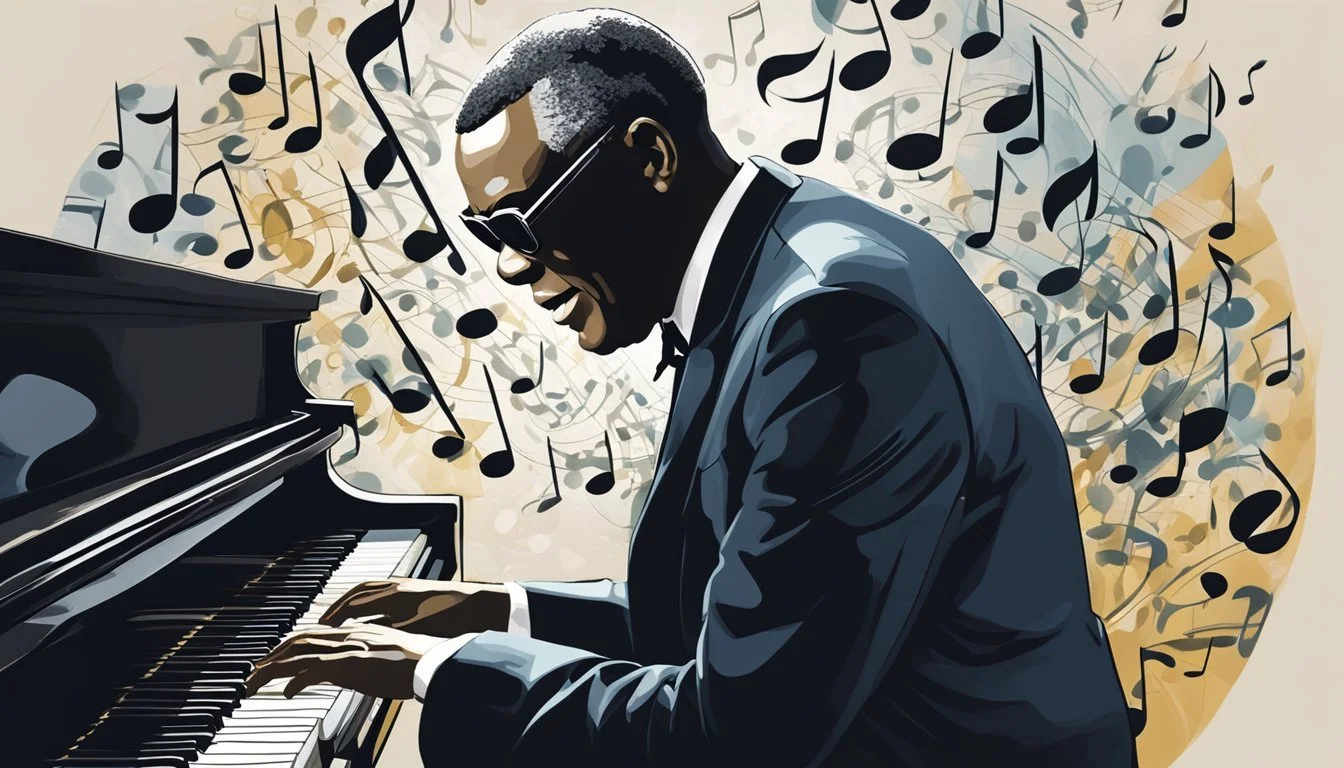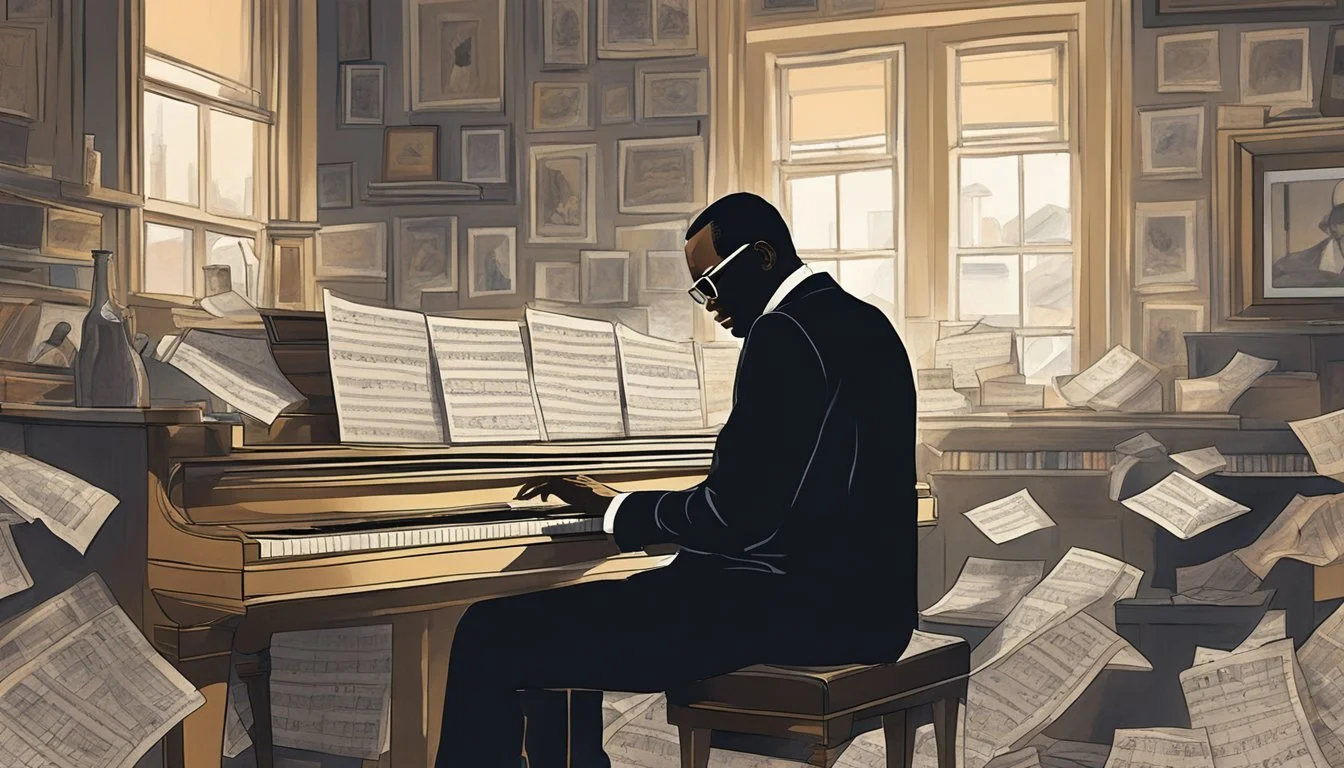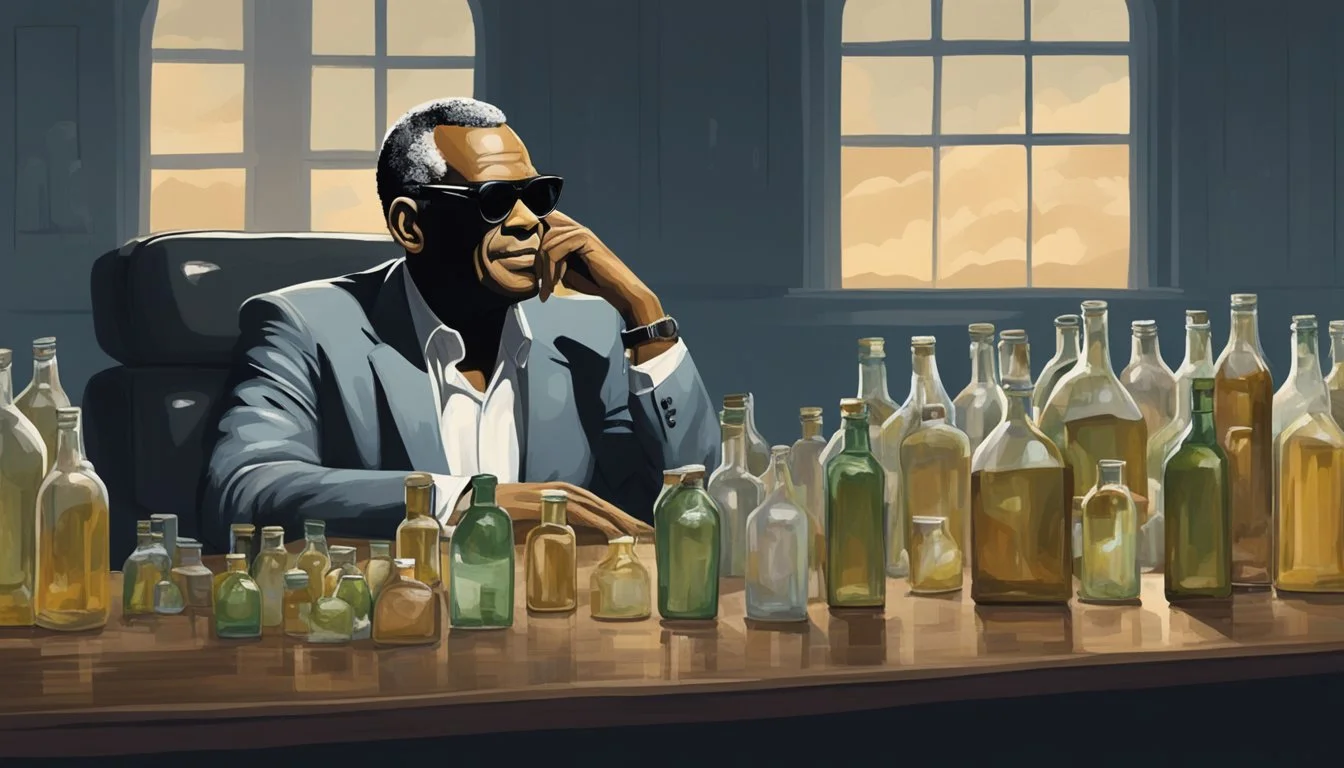Musical Genius: Ray Charles' Battle with Clinical Depression
A Hidden Struggle Behind the Fame
Ray Charles, known as "The Genius of Soul," revolutionized American music by blending gospel, jazz, blues, and country into a unique sound. Behind his iconic performances and groundbreaking compositions lay a personal struggle with clinical depression. Despite battling this mental health condition, Ray Charles continued to create influential music that resonated with millions of listeners worldwide.
Charles' journey through depression showcased his resilience and determination. Born in 1930 in Albany, Georgia, he faced numerous challenges early in life, including the loss of his sight by age seven. These experiences likely contributed to his emotional struggles, yet also fueled his passion for music as a form of expression and healing.
The legendary musician's battle with depression remained largely private during his lifetime. His ability to channel his emotions into soul-stirring performances demonstrated the power of art as a coping mechanism. Ray Charles' story serves as a testament to the complex relationship between creativity and mental health in the music industry.
The Life of Ray Charles
Ray Charles overcame immense challenges to become one of the most influential musicians in history. His journey from a poor, blind child to a musical icon exemplifies perseverance and artistic genius.
Early Years and Education
Ray Charles Robinson was born on September 23, 1930, in Albany, Georgia. He grew up in Greenville, Florida, facing poverty and racial discrimination. At age 5, Charles began losing his sight due to glaucoma, becoming completely blind by age 7.
In 1937, he enrolled at the Florida School for the Deaf and Blind in St. Augustine. There, he honed his musical talents, learning to read and write music in Braille. Charles studied classical piano and clarinet, laying the foundation for his future career.
Despite his disability, Charles developed a keen ear and remarkable memory for music. These skills would prove invaluable in his later musical innovations.
Rise to Fame
After leaving school at 15, Charles began performing in various bands across Florida. In 1948, he moved to Seattle, where he formed the McSon Trio, his first professional music group.
Charles signed with Atlantic Records in 1952, marking the beginning of his rise to stardom. His breakthrough came in 1954 with the hit single "I've Got a Woman." This song blended gospel and R&B, creating a new sound that would define his career.
Throughout the 1950s and early 1960s, Charles released a string of hits, including "What'd I Say" and "Georgia On My Mind." His unique style and powerful voice earned him the nickname "The Genius."
Pioneering Musical Style
Ray Charles revolutionized music by blending various genres. He combined elements of gospel, jazz, blues, and country to create a distinctive sound that became known as soul music.
His innovative approach broke down musical barriers and influenced countless artists across genres. Charles' ability to infuse emotion into his performances set him apart from his contemporaries.
Notable achievements include:
Recording the groundbreaking album "Modern Sounds in Country and Western Music" (1962)
Winning 17 Grammy Awards over his career
Being one of the first inductees into the Rock and Roll Hall of Fame in 1986
Charles' impact on music extended beyond his recordings, as he paved the way for future generations of artists to experiment with genre-blending.
Personal Challenges and Triumphs
Despite his professional success, Charles faced numerous personal challenges. He struggled with heroin addiction for nearly two decades, finally overcoming it in 1965 after a stint in rehab.
Charles' romantic life was complicated, involving multiple relationships and children. He fathered 12 children with 10 different women, maintaining relationships with many of them throughout his life.
In 1979, Charles received a star on the Hollywood Walk of Fame, recognizing his contributions to the entertainment industry. He continued performing and recording until shortly before his death on June 10, 2004.
Throughout his life, Charles used his platform to advocate for civil rights and support charitable causes. His resilience in the face of adversity and unwavering commitment to his art cemented his legacy as a true musical genius.
Musical Innovation and Influence
Ray Charles revolutionized popular music through his groundbreaking fusion of genres and innovative approach to soul music. His unique style and collaborations left an indelible mark on the industry, influencing countless artists across multiple generations.
Fusion of Genres
Ray Charles expertly blended elements of blues, jazz, gospel, and R&B to create a distinctive sound. His 1962 album "Modern Sounds in Country and Western Music" broke new ground by combining country music with soul and pop arrangements. This bold move not only expanded his audience but also helped bridge racial divides in music.
Charles' ability to seamlessly merge different musical styles set him apart from his contemporaries. He incorporated jazz piano techniques into R&B songs and infused gospel-inspired vocals into secular music. This genre-bending approach paved the way for future artists to experiment with cross-genre collaborations.
Innovations in Soul Music
Charles played a pivotal role in shaping soul music as we know it today. He pioneered the use of call-and-response patterns, adapting this technique from gospel music to create a more engaging and emotional performance style. His powerful vocals often featured melisma, a technique where multiple notes are sung on a single syllable.
The artist's innovative use of the Wurlitzer electric piano became a signature sound in soul music. Charles' emotional delivery and raw, passionate performances set a new standard for soul singers. His approach to arranging, which often included horn sections and backing vocalists, became a blueprint for future soul and R&B productions.
Collaborations and Influences
Ray Charles' musical genius attracted collaborations with various renowned artists. He worked with jazz luminaries like Quincy Jones, who produced several of Charles' albums. These partnerships further expanded his musical horizons and influenced his evolving style.
Charles cited Nat King Cole as a significant influence on his piano playing and vocal style. In turn, Charles inspired countless musicians across genres, including rock and roll pioneers like Elvis Presley and Jerry Lee Lewis. His impact extended to future soul and R&B artists, with James Brown and Stevie Wonder acknowledging his influence on their work.
Charles' legacy continues to shape modern music, with his innovative spirit and genre-blending approach inspiring artists to push boundaries and explore new musical territories.
Critical Acclaim and Awards
Ray Charles achieved immense recognition for his musical genius and innovative style. His groundbreaking fusion of gospel, blues, and R&B earned him numerous accolades and a lasting impact on popular music.
Grammy Awards
Ray Charles's exceptional talent was honored with 17 Grammy Awards throughout his career. His first win came in 1960 for "Georgia On My Mind," which secured Best Vocal Performance Single Record or Track, Male. Charles's album "Modern Sounds in Country and Western Music" earned him three Grammys in 1962.
Notable wins include:
1975: Best R&B Vocal Performance, Male for "Living for the City"
1993: Lifetime Achievement Award
2005: Album of the Year for "Genius Loves Company" (posthumous)
Charles's Grammy success spanned multiple genres, showcasing his versatility as an artist.
Rock and Roll Hall of Fame
Ray Charles was inducted into the Rock and Roll Hall of Fame in 1986 as part of the inaugural class. This honor recognized his pivotal role in shaping rock and roll music. Charles's induction highlighted his influence on various musical styles and his ability to transcend genre boundaries.
His innovative approach to blending genres paved the way for future generations of musicians. The Hall of Fame acknowledged Charles's contributions to soul, R&B, and pop music, cementing his status as a musical pioneer.
Cultural and Historical Impact
Ray Charles's influence extended far beyond music, establishing him as a cultural icon. His distinctive sound and performance style inspired countless artists across multiple genres. Charles broke racial barriers in the music industry, becoming one of the first African American musicians to achieve crossover success.
Key cultural contributions:
Helped popularize soul music in the 1950s and 1960s
Advocated for civil rights through his music and public stance
Influenced fashion with his signature sunglasses and suits
Charles's legacy continues to shape American music and culture, with his songs remaining relevant decades after their release.
Notable Works
Ray Charles produced an extensive catalog of influential music across multiple genres. His distinctive style and emotive performances left an indelible mark on popular music.
Hit Singles
"I Got a Woman" (1954) became one of Ray Charles' first major hits, blending gospel and R&B. The song's innovative fusion helped lay the groundwork for soul music.
"What'd I Say" (1959) broke new ground with its call-and-response format and electric piano riff. It became Charles' first top 10 pop single and a defining track of his career.
"Georgia on My Mind" (1960) showcased Charles' ability to interpret standards. His soulful rendition topped the charts and later became the official state song of Georgia.
"Hit the Road Jack" (1961) demonstrated Charles' knack for combining catchy hooks with bluesy vocals. The upbeat tune won a Grammy Award and remains one of his most recognizable songs.
Influential Albums
"Modern Sounds in Country and Western Music" (1962) broke racial barriers by reimagining country classics through Charles' unique R&B lens. The album's commercial and critical success helped bridge musical genres.
"Ray Charles Live" (1958) captured the energy of his electrifying stage presence. This recording introduced many listeners to Charles' dynamic live performances.
"The Genius of Ray Charles" (1959) featured big band arrangements and showcased his versatility across jazz and pop standards. The album cemented his reputation as a musical virtuoso.
Legacy Tracks
"Unchain My Heart" (1961) became one of Charles' signature songs, with its impassioned vocals and memorable horn section. The track has been covered by numerous artists over the years.
Charles' appearance in "The Blues Brothers" (1980) film introduced him to a new generation of fans. His performance of "Shake a Tail Feather" revitalized interest in his earlier work.
"America the Beautiful" (1972) offered a stirring interpretation of the patriotic song. Charles' version has been widely embraced and performed at significant national events.
Challenges and Controversies
Ray Charles faced numerous obstacles throughout his life and career. His battles with addiction, health issues, and racial discrimination tested his resilience and shaped his experiences as a musician.
Struggle with Addiction
Ray Charles developed a heroin addiction in the 1950s that persisted for nearly two decades. His drug use began as a coping mechanism for the pressures of fame and touring. The addiction affected his personal relationships and professional commitments.
Charles faced arrests and legal troubles due to drug possession. In 1965, he was arrested at Logan Airport in Boston, leading to a highly publicized trial. This incident prompted him to seek treatment and enter a rehabilitation program in Los Angeles.
After completing rehab, Charles remained clean for the rest of his life. He became an advocate for addiction awareness and supported rehabilitation efforts for other musicians struggling with substance abuse.
Health and Liver Disease
Ray Charles' years of drug use took a toll on his health, particularly his liver. In the 1980s, he was diagnosed with liver disease, a condition exacerbated by his history of substance abuse.
Despite his health challenges, Charles continued to perform and record music. He underwent regular medical treatments and adjusted his lifestyle to manage his condition.
In his later years, Charles became an advocate for liver disease awareness. He spoke openly about his experiences and encouraged others to prioritize their health.
Confronting Racism and Segregation
As an African American musician in the mid-20th century, Ray Charles faced significant racial discrimination and segregation. He encountered segregated venues, discriminatory treatment, and limited opportunities early in his career.
Charles used his platform to challenge racial barriers. He refused to perform at segregated concerts in Georgia in 1961, a decision that led to a lifetime ban in the state (later overturned). This stance aligned him with the growing Civil Rights Movement.
Despite facing racism, Charles' music transcended racial boundaries. His innovative blend of gospel, R&B, and jazz appealed to diverse audiences, helping bridge racial divides through music.
Influence on Other Artists
Ray Charles's innovative musical style and emotive performances left an indelible mark on the music industry. His unique blend of genres inspired countless artists across multiple generations.
Legacy in Music Industry
Ray Charles earned the moniker "Father of Soul" for his pioneering fusion of gospel, R&B, and jazz. This groundbreaking approach influenced the development of soul and rock and roll. Artists like Aretha Franklin and The Raelettes drew direct inspiration from Charles's passionate vocal delivery and piano playing.
His impact extended to Motown, shaping the label's signature sound. Many Motown artists incorporated elements of Charles's style into their performances. Charles's ability to cross genre boundaries paved the way for future musicians to experiment with diverse musical forms.
Inspiration to Future Generations
Charles's influence continues to resonate with contemporary artists. His soulful interpretations and emotional depth serve as a blueprint for singers across various genres. Many modern R&B and pop vocalists cite Charles as a major influence on their vocal techniques and stage presence.
His innovative arrangements and production methods also inspired future generations of musicians and producers. Charles's work with The Raelettes set a standard for backup vocals that is still emulated today. His integration of country music elements into soul and R&B opened doors for cross-genre collaborations in the industry.
Ray Charles's Role Outside Music
Ray Charles's influence extended far beyond his musical career. He made significant contributions to civil rights and humanitarian causes, using his fame and talent to effect positive change in society.
Contribution to Civil Rights
Ray Charles played a crucial role in the Civil Rights Movement. He refused to perform at segregated venues, helping integrate concert halls across the South. In 1961, he canceled a show in Augusta, Georgia due to segregated seating, facing a lawsuit but standing firm in his principles.
Charles used his music to promote equality. His rendition of "America the Beautiful" became an anthem for unity and diversity. He also supported Martin Luther King Jr.'s efforts, performing at benefit concerts and donating to civil rights organizations.
As a cultural icon, Charles's success helped break down racial barriers in the entertainment industry. His crossover appeal brought diverse audiences together, fostering understanding between different racial groups.
Humanitarian Efforts
Ray Charles was deeply committed to philanthropic work. In 1986, he founded The Robinson Foundation for Hearing Disorders, later renamed The Ray Charles Foundation. This organization provides financial support for cochlear implants and research into hearing disorders.
Charles participated in the recording of "We Are the World" in 1985. This charity single raised millions for famine relief in Africa. He also supported other humanitarian causes, including education and disadvantaged youth programs.
In 2002, Charles donated $1 million to Morehouse College in Atlanta. This gift established a scholarship fund for music students. He also contributed to natural disaster relief efforts and various children's charities throughout his career.
Conclusion
Ray Charles' battle with clinical depression shaped his artistic journey profoundly. His ability to channel emotional pain into soulful music resonated deeply with audiences worldwide.
Charles' legacy extends far beyond his musical innovations. He stands as a testament to resilience in the face of mental health challenges. His openness about his struggles helped reduce stigma around depression.
The interplay between Charles' depression and his creative genius remains a subject of fascination. His experiences highlight the complex relationship between mental health and artistic expression.
Charles' life demonstrates the importance of seeking help and support. Despite periods of darkness, he found ways to manage his depression and continue making impactful music.
Ray Charles left an indelible mark on American music. His courage in confronting depression while pursuing his passion inspires musicians and fans alike. Charles' story reminds us that even in struggle, profound beauty and art can emerge.








